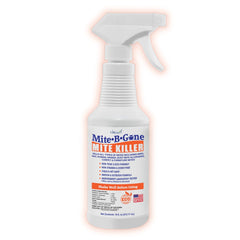Understanding Dog Mites: What They Are and How to Handle Them
As dog owners, we want to provide the best care for our furry friends, but sometimes unexpected issues arise, like dog mites. These tiny parasites can cause discomfort and a range of skin problems for our dogs, but understanding them can help you protect your pet. In this blog, we’ll dive into what dog mites are, the types that affect dogs, the symptoms to watch for, and how to treat and prevent them.
What Are Dog Mites?
Mites are microscopic arthropods that can infest your dog's skin, causing irritation, itching, and even hair loss. They are not insects but rather arachnids, which makes them cousins to spiders, ticks, and scorpions. While some types of mites are a normal part of your dog’s skin ecosystem, others can lead to health issues. Mite infestations are often more common in certain breeds, puppies, and dogs with weakened immune systems.
Types of Dog Mites
There are several types of mites that can affect dogs, with each causing its own unique set of symptoms. The most common types include:
-
Sarcoptic Mites (Scabies)
Sarcoptic mange, also known as scabies when present on a human, is one of the most infamous mite infestations in dogs. Caused by the Sarcoptes scabiei mite, it is highly contagious and can spread quickly to other pets and even humans. This mite burrows into the skin, causing severe itching, hair loss, and crusty scabs. Dogs with scabies often develop secondary bacterial infections due to constant scratching. -
Demodex Mites (Demodectic Mange)
Demodex mites are naturally found on the skin of most dogs. They live in the hair follicles and sebaceous glands. However, when a dog’s immune system is compromised, these mites can multiply excessively, leading to demodectic mange. Symptoms include hair loss, reddened skin, and sometimes lesions. While demodicosis is not contagious, it can cause significant discomfort for your dog. -
Otodectes Mites (Ear Mites)
Ear mites, Otodectes cynotis, are common in puppies and outdoor dogs. These mites cause intense itching inside the ears, leading to head shaking, ear scratching, and dark, waxy discharge. If left untreated, ear mite infestations can lead to infections and hearing loss. -
Cheyletiella Mites (Walking Dandruff)
These mites, also known as "walking dandruff," are visible to the naked eye and cause a flaking, scaly appearance on the dog’s skin. They are highly contagious to other dogs and sometimes to humans as well. Affected dogs often develop sores, itching, and a rough coat.
Symptoms of Mite Infestation
While mite infestations vary depending on the type of mite involved, common symptoms include:
-
Itching and Scratching: The most obvious sign of mites is excessive scratching, as the mites burrow into the skin or live on the surface, causing irritation.
-
Hair Loss: Bald patches, especially around the ears, face, and legs, may appear as mites damage the hair follicles.
-
Red, Inflamed Skin: Inflammation, redness, and the appearance of sores or crusts are common, particularly with sarcoptic mange.
-
Scaly or Crusty Skin: Dogs with Demodex or Cheyletiella mites often have a scaly, dandruff-like appearance on their skin.
-
Ear Discharge: With ear mites, a dark, waxy discharge and frequent ear scratching or head shaking are telltale signs.
Diagnosing Mite Infestations
If you suspect your dog has mites, it’s essential to consult with a veterinarian. The diagnosis usually involves:
-
Physical Examination: The vet will inspect your dog’s skin and ears for signs of mites or mange.
-
Skin Scraping: A skin scraping may be done to collect a sample of the skin and hair follicles, which can be examined under a microscope for mites.
-
Ear Cytology: If ear mites are suspected, the vet will examine the ear discharge to identify the presence of mites.
Treatment Options for Mite Infestations
The treatment for mite infestations varies depending on the type of mite and the severity of the infection. Common treatments include:
-
Topical Treatments: Medicated shampoos, creams, and ointments are often prescribed to kill mites and soothe the skin. These treatments may need to be applied regularly over several weeks. Mite-B-Gone Mite Killer is an all-natural option used to treat topical mites safely on dogs and other animals. For tougher mites such as mange or pet scabies, you'll need a stronger treatment such as our Pet Mange to aid in your fight against dog mange and mites.
-
Oral Medications: For more severe cases, vets may prescribe oral medications, such as ivermectin or milbemycin, which help to kill mites and treat secondary infections.
-
Injections: In cases of severe sarcoptic mange or demodicosis, the vet may administer injectable treatments to target the mites.
-
Ear Treatments: For ear mites, ear drops or ointments are often used to kill the mites and reduce inflammation.
-
Antibiotics or Antifungals: If your dog has developed secondary bacterial or fungal infections due to the mite infestation, antibiotics or antifungal medications may be needed.
Preventing Mite Infestations
While it’s not always possible to prevent mite infestations completely, there are steps you can take to reduce the risk:
-
Regular Grooming: Keep your dog’s coat clean and well-groomed. Brushing regularly can help remove dead skin and hair, making it more difficult for mites to thrive.
-
Keep Your Dog Clean: Bathe your dog with a gentle, dog-safe shampoo to remove dirt, debris, and potential parasites. This is especially important if your dog spends a lot of time outdoors.
-
Check Your Dog’s Ears: Regularly inspect your dog’s ears for signs of irritation, discharge, or scratching.
-
Maintain Good Hygiene: Ensure your dog’s bedding, toys, and living areas are clean. Wash their bedding frequently and avoid contact with infected animals.
-
Mite Repellants: Use natural and pet-safe miticides such as our Mite-B-Gone Spray as a daily preventative to ensure your pups always stay itch-free, no matter how many butts they sniff at the dog park.
-
Veterinary Checkups: Regular vet visits can help catch potential mite infestations early before they become a serious problem.
Conclusion
Mite infestations can be a frustrating and uncomfortable experience for both dogs and their owners, but with prompt diagnosis and treatment, most infestations can be successfully managed. Always consult your veterinarian if you notice signs of mites, as they can help guide you through the proper steps to restore your dog’s health. By staying vigilant and proactive, you can ensure your furry companion remains happy, healthy, and mite-free. Below we have selected some of our most effective treatments for combating Dog Mites!








